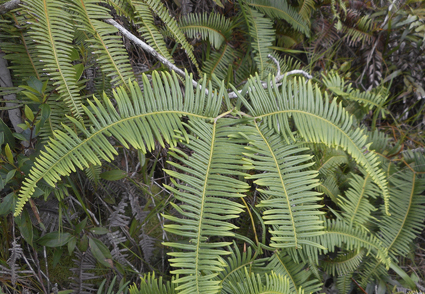Abstract
We recognized Dicranopteris spissa (Fée) L.V.Lima & Salino comb. nov. as a segregate species distinct from Dicranopteris rufinervis and other gleichenioid ferns occurring in Brazil. This study provides taxonomic background, descriptions, images, maps, and comments regarding the morphology, ecology, and distribution of D. spissa, as well as an identification key for all Brazilian species of Dicranopteris.
References
<p>Andersen, E. & Øllgaard, B. (1996) A note on some morphological terms of the leaf in the Gleicheniaceae. <em>American Fern Journal </em>86: 52–57. https://doi.org/10.2307/1547368</p>
<p>Bachman, S., Moat, J., de la Torre, J. & Scott, B. (2011) Supporting Red List threat assessments with GeoCAT: geospatial conservation assessment tool. <em>ZooKeys</em> 150: 117–126. https://doi.org/10.3897/zookeys.150.2109</p>
<p>Bernhardi, J.J. (1805) Dritter Versuch einer Anordnung der Farrnkräuter. <em>Schrader’s Neues Journal für die Botanik</em> 1: 1–50.</p>
<p>ESRI (2011) ArcGIS Desktop: Release 10. Redlands, CA: Environmental Systems Research Institute.</p>
<p>Holttum, R.E. (1957) Florae Malesianae Precursores XVI: On the taxonomic subbranch of the Gleicheniaceae, with descriptions of new Malaysian species and varieties. <em>Reinwardtia</em> 4: 257–280.</p>
<p>Kessler, M. & Smith, A.R. (2018) Prodromus of a fern flora for Bolivia. XI. Gleicheniaceae. <em>Phytotaxa</em> 344: 53-63. https://doi.org/10.11646/phytotaxa.344.1.7</p>
<p>Klotzsch, J.F. (1844) Beiträge zu einer Flora der Aequinoctial-Gegenden der neuen Welt. <em>Linnaea </em>18: 515–556. https://doi.org/10.5962/bhl.title.6148</p>
<p>Li, C., Lu, S., Ma, J. & Yang, Q. (2010) Phylogeny and divergence of Gleicheniaceae inferred from three plastid genes. <em>Acta Palaeontologica Sinica</em> 49: 64–72.</p>
<p>Lima, L.V. & Salino, A. (2018) The fern family Gleicheniaceae (Polypodiopsida) in Brazil. <em>Phytotaxa</em> 358: 199–234. https://doi.org/10.11646/phytotaxa.358.3.1</p>
<p>Lima, L.V. & Salino, A. (2018) The fern family Gleicheniaceae (Polypodiopsida) in Brazil. <em>Phytotaxa</em> 358: 199–234. https://doi.org/10.11646/phytotaxa.358.3.1</p>
<p>Martius, H. (1834) <em>Icones Plantarum Cryptogamicarum</em>. Munich.</p>
<p>Maxon, W.R. (1922) Studies of tropical American fern–No. 7. <em>Contributions from the United States National Herbarium</em> 24: 33–63.</p>
<p>Mickel, J.T. & Smith, A.R. (2004) The pteridophytes of Mexico. <em>Memoirs of the New York Botanical Garden</em> 88: 1–1054.</p>
<p>PPG I (2016) A community-derived classification for extant lycopods and ferns. <em>Journal of Systematics and Evolution</em> 54: 563–603. https://doi.org/10.1111/jse.12229</p>
<p>Rojas, M. (1992) The species problem and conservation: what are we protecting? <em>Conservation Biology</em> 6: 170–178. https://doi.org/10.1046/j.1523-1739.1992.620170.x</p>
<p>Thiers, B. (2021) [continuously updated] Index Herbariorum: A global directory of public herbaria and associated staff. New York Botanical Garden’s Virtual Herbarium. Available from: http://sweetgum.nybg.org/science/ih/ (accessed 12 July 2021)</p>
<p>Tryon, R.M. & Stolze, R.G. (1989) Pteridophyta of Peru. Part I. 1. Ophioglossaceae-12. Cyatheaceae. <em>Fieldiana Botany</em>, n.s. 20: 111–1138.</p>
<p>Underwood, L.M. (1907) American Ferns VIII. A preliminary review of the North American Gleicheniaceae. <em>Bulletin of the Torrey Botanical Club</em> 34: 243–262. https://doi.org/10.2307/2560334</p>
<p>Bachman, S., Moat, J., de la Torre, J. & Scott, B. (2011) Supporting Red List threat assessments with GeoCAT: geospatial conservation assessment tool. <em>ZooKeys</em> 150: 117–126. https://doi.org/10.3897/zookeys.150.2109</p>
<p>Bernhardi, J.J. (1805) Dritter Versuch einer Anordnung der Farrnkräuter. <em>Schrader’s Neues Journal für die Botanik</em> 1: 1–50.</p>
<p>ESRI (2011) ArcGIS Desktop: Release 10. Redlands, CA: Environmental Systems Research Institute.</p>
<p>Holttum, R.E. (1957) Florae Malesianae Precursores XVI: On the taxonomic subbranch of the Gleicheniaceae, with descriptions of new Malaysian species and varieties. <em>Reinwardtia</em> 4: 257–280.</p>
<p>Kessler, M. & Smith, A.R. (2018) Prodromus of a fern flora for Bolivia. XI. Gleicheniaceae. <em>Phytotaxa</em> 344: 53-63. https://doi.org/10.11646/phytotaxa.344.1.7</p>
<p>Klotzsch, J.F. (1844) Beiträge zu einer Flora der Aequinoctial-Gegenden der neuen Welt. <em>Linnaea </em>18: 515–556. https://doi.org/10.5962/bhl.title.6148</p>
<p>Li, C., Lu, S., Ma, J. & Yang, Q. (2010) Phylogeny and divergence of Gleicheniaceae inferred from three plastid genes. <em>Acta Palaeontologica Sinica</em> 49: 64–72.</p>
<p>Lima, L.V. & Salino, A. (2018) The fern family Gleicheniaceae (Polypodiopsida) in Brazil. <em>Phytotaxa</em> 358: 199–234. https://doi.org/10.11646/phytotaxa.358.3.1</p>
<p>Lima, L.V. & Salino, A. (2018) The fern family Gleicheniaceae (Polypodiopsida) in Brazil. <em>Phytotaxa</em> 358: 199–234. https://doi.org/10.11646/phytotaxa.358.3.1</p>
<p>Martius, H. (1834) <em>Icones Plantarum Cryptogamicarum</em>. Munich.</p>
<p>Maxon, W.R. (1922) Studies of tropical American fern–No. 7. <em>Contributions from the United States National Herbarium</em> 24: 33–63.</p>
<p>Mickel, J.T. & Smith, A.R. (2004) The pteridophytes of Mexico. <em>Memoirs of the New York Botanical Garden</em> 88: 1–1054.</p>
<p>PPG I (2016) A community-derived classification for extant lycopods and ferns. <em>Journal of Systematics and Evolution</em> 54: 563–603. https://doi.org/10.1111/jse.12229</p>
<p>Rojas, M. (1992) The species problem and conservation: what are we protecting? <em>Conservation Biology</em> 6: 170–178. https://doi.org/10.1046/j.1523-1739.1992.620170.x</p>
<p>Thiers, B. (2021) [continuously updated] Index Herbariorum: A global directory of public herbaria and associated staff. New York Botanical Garden’s Virtual Herbarium. Available from: http://sweetgum.nybg.org/science/ih/ (accessed 12 July 2021)</p>
<p>Tryon, R.M. & Stolze, R.G. (1989) Pteridophyta of Peru. Part I. 1. Ophioglossaceae-12. Cyatheaceae. <em>Fieldiana Botany</em>, n.s. 20: 111–1138.</p>
<p>Underwood, L.M. (1907) American Ferns VIII. A preliminary review of the North American Gleicheniaceae. <em>Bulletin of the Torrey Botanical Club</em> 34: 243–262. https://doi.org/10.2307/2560334</p>


